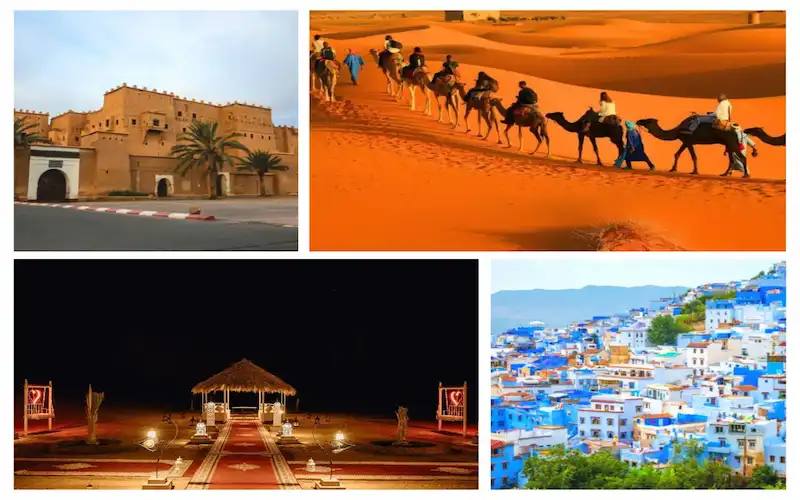Exploring Morocco by car gives you the freedom to move at your own pace.
You can visit imperial cities, cross the Sahara Desert, and explore small mountain villages far from tourist crowds.
This morocco travel itinerary is designed for travelers who want to dive deep into Morocco’s culture, nature, and everyday life.
It works well as a morocco itinerary 8 days, but can be easily expanded into a morocco itinerary 10 days or shortened into a morocco itinerary 7 days depending on your schedule.
Kid-Friendly Attractions in Marrakech
There is no shortage of family-friendly activities in Marrakech. Some of the best places to visit include:
- Jemaa El-Fna Square: In the evening, this lively square turns into an open-air theater with musicians, storytellers, and performers that fascinate children.
- Majorelle Garden: A peaceful retreat where kids can discover exotic plants and beautiful fountains.
- Koutoubia Gardens: A perfect spot for families to relax and let children play in a safe, green space.
- Oasiria Water Park: A fun escape from the heat, offering slides, pools, and lazy rivers.
- Palooza Land: A dinosaur-themed amusement park that offers both entertainment and education.
For a more immersive experience, families can try Marrakech with kids excursions that include camel rides, cooking classes, and cultural workshops.
Family-Friendly Excursions Outside Marrakech.
Marrakech is not just about the city. Families looking for adventure can explore the stunning landscapes surrounding it. Desert excursions from Marrakech with kids provide a unique way to experience the Moroccan countryside.
- The Agafay Desert: Unlike the Sahara, this rocky desert is just an hour from the city and offers camel rides and breathtaking sunset views.
- The Atlas Mountains: A refreshing escape where families can visit Berber villages, go hiking, or ride donkeys.
- The Palmeraie: A vast palm grove where families can take relaxing camel rides and enjoy a glimpse of traditional Moroccan life.
For those wanting a mix of adventure and relaxation, family-friendly tours in Marrakech often include stops at these scenic locations, allowing for a well-rounded trip.
Best Family Hotels in Marrakech.
Choosing the right accommodation is essential for a comfortable stay. Best family hotels in Marrakech offer amenities like pools, spacious rooms, and play areas. Many riads also cater to families, providing a more authentic experience with Moroccan hospitality. Staying near the Medina allows easy access to attractions, while resorts outside the city offer more space and tranquility.
Making the Most of a Family Vacation in Marrakech.
Marrakech is an exciting destination, but a little planning helps ensure a smooth trip. Families should:
- Visit major attractions early in the morning or late in the afternoon to avoid the midday heat.
- Bring comfortable shoes, as walking is a big part of exploring the city.
- Be open to the spontaneous interactions that make Marrakech such a magical place.
With so many things to do in Marrakech with kids, every day is an adventure. Whether exploring the top attractions for kids in Marrakech, taking a guided tour, or relaxing in a lush garden, the city has something for every family. A family vacation in Marrakech is more than a trip—it’s an experience that creates lasting memories.
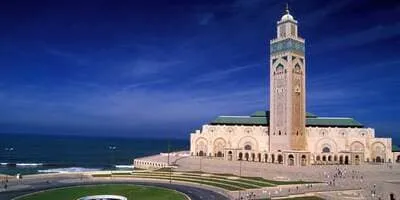
Day 1: Casablanca – The Gateway to Morocco
Start your morocco trip itinerary in Casablanca, the country’s largest city.
While not always loved by travelers, it has a few places worth seeing.
Highlights
- Hassan II Mosque: one of the world’s largest, built partly over the Atlantic Ocean
- Rick’s Café: a recreation of the movie set from Casablanca
- Mohamed V Square: surrounded by colonial architecture
A half-day here is enough. Focus on the essentials, then hit the road.
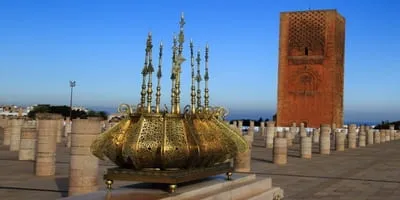
Day 2: Rabat – The Political Capital
Rabat is a quiet capital with charm and history.
It often gets skipped in a one week in Morocco, but it’s worth a stop if you’re nearby.
What to See
- Kasbah of the Udayas: beautiful old fortress overlooking the ocean
- Hassan Tower and Mausoleum of Mohammed V
- Andalusian Gardens
- A calm local souk where you can shop without pressure
Spend a full day here to take in the relaxed atmosphere and historic spots.
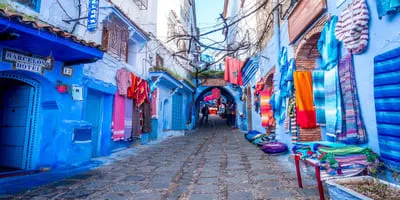
Day 3: Chefchaouen – The Blue Pearl
One of the most photogenic places in Morocco.
Chefchaouen, hidden in the Rif Mountains, is a favorite on every morocco itinerary.
Things to Do
- Walk through the medina and admire the blue-painted streets
- Watch the sunset from the Spanish Mosque viewpoint
- Try a local tajine on a rooftop terrace
- Hike to Akchour Waterfalls, a natural gem just 45 minutes away
You don’t need a long stay. A day and a night are perfect to relax and explore.
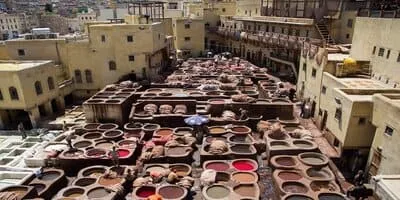
Day 4–5: Fès – Morocco’s Cultural Capital
No morocco itinerary 10 days is complete without Fès.
This imperial city is intense, historic, and unforgettable.
Must-Sees
- The old medina of Fès el-Bali: a UNESCO World Heritage Site
- Chouara Tanneries: open-air leather dyeing pits
- Al Quaraouiyine University: the oldest university in the world
- Bou Inania Madrasa: a beautiful example of Islamic architecture
Spend two nights here. Hire a guide if you want to avoid getting lost in the medina.
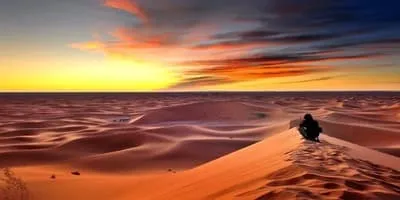
Day 6: Merzouga – The Erg Chebbi Dunes
Drive into the desert to reach Merzouga, the starting point for your Sahara adventure.
This is a must-do in any morocco itinerary.
Top Experiences
- Camel ride at sunset through the Erg Chebbi dunes
- Overnight in a traditional Berber desert camp
- Watch the stars in the silence of the Sahara
- Wake early to catch the sunrise over the dunes
Even if you’re short on time, many tours offer a 3 days Marrakech desert tour that includes this experience.

Day 7: Aït Ben Haddou – The Kasbah Route
On your way west, take the scenic Road of a Thousand Kasbahs.
This part of your morocco trip itinerary feels like stepping into another era.
Recommended Stops
- Aït Ben Haddou: a UNESCO-listed mudbrick village used in movies like Gladiator and Game of Thrones
- Ouarzazate: home to movie studios and old kasbahs
- The Dades Valley if you have extra time
This day mixes desert views, historic buildings, and cinematic landscapes.
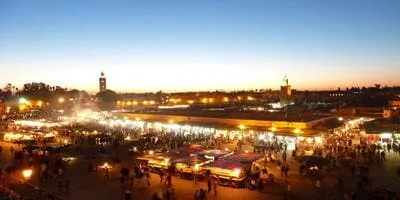
Day 8: Marrakech – The Red City
End your 8-day Morocco itinerary in Marrakech, Morocco’s most famous city.
It’s chaotic, loud, and full of energy.
What to Explore
- Jemaa el-Fnaa: a massive square packed with life, especially at night
- Jardin Majorelle: lush gardens formerly owned by Yves Saint Laurent
- Ben Youssef Madrasa: a peaceful historical site
- The souks: endless alleyways selling spices, rugs, lamps, and ceramics
If possible, stay two nights. The city deserves more than a rushed visit.
Planning Tips for Your Morocco Itinerary
How Many Days?
- With 7 days in Morocco, skip Rabat or fly between Fès and Marrakech
- With 10 days in Morocco, add a stop in the Atlas Mountains or the Todra Gorge
When to Go?
- Spring (March to May) and Fall (September to November) offer the best weather
- Avoid July–August for desert travel unless you enjoy extreme heat
How to Get Around?
- Rent a car for full freedom
- Or join a guided tour like a 3 days Marrakech desert tour for specific parts
Best Morocco Itinerary for First-Timers: A Human Touch
If you’re dreaming of Morocco and wondering how to make the most of your first journey, here’s a thoughtfully crafted 8-day adventure that blends iconic sites, authentic experiences, and the gentle surprises only Morocco can offer. This itinerary is tailored for newcomers, with real-world tips and the warmth of local culture throughout.
Day 1: Casablanca – Where Modern Morocco Begins
Touch down in Casablanca, where the Atlantic breeze meets vibrant city life. Begin with the breathtaking Hassan II Mosque—its architecture and seaside setting are truly unforgettable. Hop over to Rick’s Café for a nostalgic nod to cinema lovers, and watch the world go by at Mohamed V Square, where French colonial design blends with everyday hustle. Just a taste here is plenty; don’t linger too long—Morocco’s true magic lies ahead.
Day 2: Rabat – Quiet Confidence and Ocean Breezes
Head north along the coast to Rabat, the nation’s laid-back capital. The Kasbah of the Udayas invites you to walled gardens and cliffside views, while the Hassan Tower and Mausoleum of Mohammed V echo stories of Morocco’s royal past. Rabat is a breath of calm, offering you a chance to settle into the mellow North African pace before the wilder cities to come.
Day 3: Chefchaouen – The Blue Pearl in the Mountains
Lose yourself in the dreamy blue maze of Chefchaouen, nestled among the Rif Mountains. Snap photos as you wander the cobalt streets, then follow the locals uphill to the Spanish Mosque—sunsets here paint the whole valley gold and indigo. If you seek nature, a detour to the Akchour Waterfalls promises greenery and fresh mountain air. Allow yourself to slow down and be charmed.
Days 4-5: Fès – The Heartbeat of Moroccan Heritage
Dive into the labyrinthine medina of Fès el-Bali, where donkeys still ply the alleys and centuries-old crafts come alive at the Chouara Tanneries. Stop at Al Quaraouiyine University, the world’s oldest, and soak in the spiritual echoes at hidden mosques and madrasas. Fès deserves two nights—let curiosity guide you, hire a local guide to avoid getting lost, and treat your senses to saffron, leather, and music at every turn.
Day 6: Merzouga – Into the Sahara Dreamscape
Embark on a driving adventure into the Sahara. In Merzouga, swap your car for a camel and trek deep into the Erg Chebbi dunes. Sleep beneath starry skies in a Berber camp—share stories around the fire, savor sweet mint tea, and wake early for sunrise, when the sand ripples with soft orange light. Here, the silence is magical, and your memories will last a lifetime.
Day 7: Aït Ben Haddou – Storybook Scenery on the Kasbah Trail
Journey along the historic Road of a Thousand Kasbahs, stopping at legendary Aït Ben Haddou. This UNESCO village, with its earthen towers and film-famous landscape, feels frozen in time. If your heart or schedule allows, take a side trip to the film studios of Ouarzazate or the dramatic Dades Valley for another taste of Morocco’s wild beauty.
Day 8: Marrakech – A Vibrant Finale
Let Morocco’s energy crescendo in Marrakech. Wander the iconic chaos of Jemaa el-Fnaa, where street performers and fragrant food stalls dazzle every sense. Find peace in the lush Jardin Majorelle, once home to Yves Saint Laurent, and admire the architecture of Ben Youssef Madrasa. Leave time to haggle in the souks for a true Moroccan treasure before your journey ends.
How Many Days Do You Need for a Morocco Itinerary?
The ideal duration for a Morocco trip depends on your travel style and what experiences you want. Here’s a quick guide to help you choose:
7 Days: Highlights in a Week
- Great for: Travelers with limited time
- Focus on: Major cities and the Sahara
- Typical Route:
- Casablanca
- Fès
- Merzouga (Sahara Desert)
- Marrakech
- Tip: May need to skip stops like Rabat or shorten your stay in each city.
8–10 Days: Relaxed and Diverse
- Great for: First-timers who want to see more without rushing
- What’s Possible:
- Add Chefchaouen (the “Blue Pearl”)
- Include Rabat for history and architecture
- See Aït Ben Haddou
- Optional side trips to the Atlas Mountains or Todra Gorge
- Benefit: Balances sightseeing, cultural immersion, and leisure.
11–14 Days: Complete Exploration
- Great for: Enthusiasts seeking a deep dive
- Broaden the Experience:
- Imperial cities (Rabat, Fès, Marrakech, Meknes)
- The Sahara and overnight desert camps
- Mountain villages and coastal towns like Essaouira
- Scenic detours: Dades Valley, Todra Gorge
- Advantage: Enjoy scenic drives, relax in each destination, and experience local culture more fully.
Most travelers find 8–10 days to be the sweet spot—enough to capture Morocco’s variety while keeping a comfortable travel pace.
Must-See Places on a Morocco Itinerary
Whether you have a week or two, these destinations are typically considered Morocco’s unmissable highlights:
1. Casablanca
- Hassan II Mosque: Iconic architecture over the Atlantic.
- Rick’s Café & Mohamed V Square: Taste of history and city life.
2. Rabat
- Kasbah of the Udayas, Hassan Tower, Mausoleum of Mohammed V: Blend of history and tranquility.
- Andalusian Gardens: Peaceful retreat in the capital.
3. Chefchaouen (The Blue Pearl)
- Medina: Famous blue streets.
- Spanish Mosque: Sunset views.
- Akchour Waterfalls: Nature near town.
4. Fès
- Fès el-Bali (old medina): UNESCO World Heritage.
- Chouara Tanneries and Al Quaraouiyine University: Ancient traditions, education, and crafts.
- Bou Inania Madrasa: Islamic architectural gem.
5. Merzouga (Sahara Desert)
- Erg Chebbi Dunes: Camel rides, sunrise, and star-filled nights.
- Berber Camp: Authentic desert experience.
6. Aït Ben Haddou
- Kasbah: Ancient mudbrick village—famous filming location.
7. Marrakech
- Jemaa el-Fnaa: Lively square with food, music, and magic.
- Jardin Majorelle: Exotic gardens.
- Ben Youssef Madrasa & Souks: History and shopping galore.
8. (Optional) Atlas Mountains
- Hiking, Berber culture, and Toubkal National Park for trekking.
9. (Optional) Todra Gorge
- Towering canyon popular for hiking and photography.
At a Glance: Morocco Itinerary Planner
|
Duration |
What You’ll Experience |
Who It Suits |
|
7 Days |
Key highlights, fast-paced trip |
Time-limited travelers |
|
8–10 Days |
Balanced adventure (cities, desert, mountains), relaxed pace |
First-time visitors |
|
11–14 Days |
In-depth exploration (coasts, mountains, detours, extended cultural immersion) |
Slow travelers, explorers |
Whichever duration you choose, Morocco offers a captivating mix of ancient history, natural wonders, and vibrant culture—leaving you with unforgettable memories.
Is It Safe to Follow a Morocco Itinerary by Car?
Yes, driving through Morocco is generally safe and a fantastic way to experience the country at your own pace. With the right preparations and awareness, you can navigate both vibrant cities and remote landscapes with confidence.
Essential Safety Tips for Driving in Morocco
- Road Conditions:
- Main Roads & Highways: Well maintained, connecting major cities like Casablanca, Fès, and Marrakech.
- Rural/Mountain Roads: Can be rough, narrow, or poorly marked—slow down and remain vigilant, especially when heading to villages or mountain passes.
- Traffic & Driving Style:
- Expect city traffic to be hectic—scooters, pedestrians, and vendors often compete for space, especially in Marrakech and Casablanca.
- Rural areas are calmer but require navigating around livestock or sudden obstacles.
- Adhere to posted speed limits and drive defensively, as local driving norms may differ from what you’re used to.
- Navigation:
- GPS or offline maps are strongly recommended—reception can be weak in remote areas.
- Knowing a few words in French or Arabic can help you if you need directions outside tourist zones.
- Fuel & Supplies:
- Fill up your tank before long journeys, especially towards the Sahara or less populated regions.
- Carry water and snacks; distances between towns (and services) can be significant.
- Security:
- Petty car theft can occur—lock your vehicle and keep valuables out of view.
- Avoid night driving, particularly on poorly lit rural or mountain roads.
- Documentation:
- Carry your driver’s license, passport, and rental agreement at all times.
- Ensure everyone wears a seat belt; it’s the law.
- Roadside Assistance:
- Opt for reputable rental companies with 24/7 roadside support.
- Alternatives:
- If driving feels stressful, consider hiring a local driver or arranging a private tour—a popular, worry-free option.
Sample 7-Day Morocco Itinerary by Car
This road trip showcases Morocco’s highlights without feeling rushed:
Day 1: Casablanca – Arrival & Urban Discoveries
- Hassan II Mosque (oceanside marvel)
- Rick’s Café (movie nostalgia)
- Mohamed V Square
- Overnight in Casablanca
Day 2: Rabat – Tranquil Capital
- Kasbah of the Udayas, Hassan Tower, Mausoleum of Mohammed V
- Andalusian Gardens
- Night in Rabat
Day 3: Chefchaouen – Blue Pearl Escape
- Wind through the Rif Mountains (be mindful on twisty roads)
- Chefchaouen’s blue medina, sunset at the Spanish Mosque
- Optional: Akchour Waterfalls
- Night in Chefchaouen
Day 4: Fès – Culture & Craftsmanship
- Drive south to Fès
- Fès el-Bali (medina), Chouara Tanneries, Al Quaraouiyine University
- Hire a guide for the medina labyrinth
- Night in Fès
Day 5: Merzouga – Into the Sahara
- Long scenic drive via mountains and valleys to the Erg Chebbi dunes
- Camel ride at sunset, sleep in a Berber camp under the stars
- Night in Merzouga
Day 6: Aït Ben Haddou & Ouarzazate – Desert Heritage
- Journey west to Aït Ben Haddou (UNESCO mudbrick fortress)
- Visit Ouarzazate’s film studios if time allows
- Optional detour: Dades Valley
- Night in Aït Ben Haddou or Ouarzazate
Day 7: Marrakech – The Vibrant Finale
- Arrive in Marrakech, experience:
- Jemaa el-Fnaa (historic main square)
- Jardin Majorelle
- Ben Youssef Madrasa
- The maze of souks (market streets)
- Farewell dinner overlooking lively squares
- Night in Marrakech
Travel Tips
- Plan for breaks on long drives.
- AC is crucial in warmer months—confirm before taking your rental.
- Dress modestly, especially outside major cities and at religious sites.
- Be respectful of local customs: always ask before taking photos of people.
A self-drive Morocco itinerary rewards travelers with flexibility and the joy of discovery—from bustling medinas to desert silence and mountain views. For added peace of mind, use a reliable car, stay alert on the road, and never hesitate to ask locals for help—they’re known for their hospitality!
Best Time to Follow a Morocco Itinerary
Choosing the best time for your Morocco adventure depends on the experiences you want and your weather preferences. Morocco’s climate varies by region, but spring and fall are generally considered ideal for most travelers.
1. Spring (March to May)
- Weather: Pleasant and mild, with daytime temperatures averaging 18°C–25°C (64°F–77°F).
- Highlights:
- Ideal for exploring cities, trekking in the Atlas Mountains, and overnight desert trips.
- Landscapes are lush—perfect for scenic drives and hikes.
- Why Go: Comfortably warm for sightseeing, active adventures, and cultural experiences throughout the country.
2. Fall (September to November)
- Weather: Mild and comfortable; early fall (September) can still be warm, especially in the south (25°C–35°C / 77°F–95°F), but it cools to comfortable levels by October-November.
- Highlights:
- Great for city tours, mountain hikes, and desert excursions.
- Beautiful autumn colors in valley regions.
- Why Go: After the summer heat fades, Morocco becomes more temperate and inviting for both urban exploration and outdoor activities.
3. Winter (December to February)
- Weather: Coolest season, especially at night. Coastal cities like Casablanca and Marrakech stay mild (12°C–20°C / 54°F–68°F), but mountain and desert areas can be chilly, especially after dark.
- Highlights:
- Fewer crowds and peaceful city sightseeing.
- Snow-capped peaks in the Atlas Mountains for a unique view.
- Why Go: If you prefer quieter markets and cooler weather for city travel, winter is appealing. Desert and mountain adventures are possible, but pack for cold evenings.
4. Summer (June to August)
- Weather: Very hot, particularly in the inland and southern regions (Marrakech, Fès, Sahara), often exceeding 35°C (95°F), with desert highs up to 45°C (113°F).
- Highlights:
- Coastal cities (Casablanca, Essaouira, Agadir) are cooler thanks to ocean breezes.
- Festivals and lively beach scenes in resort towns.
- Why Avoid: Inland travel (cities/desert) can be uncomfortable or dangerous due to extreme heat. Best to stick to the coast or high mountains if visiting in summer.
At a Glance: Seasonal Comparison
|
Season |
Temperature Range |
Best For |
Possible Drawbacks |
|
Spring |
18–25°C (64–77°F) |
Sightseeing, hiking, desert tours |
Moderate crowds in major cities |
|
Fall |
18–30°C (64–86°F) |
All-round activities |
Still warm in September |
|
Winter |
12–20°C (54–68°F) (days) |
City escapes, quiet trips |
Too cold for Sahara camping, snow/travel delays in mountains |
|
Summer |
30–45°C (86–113°F) inland |
Beaches, mountain retreats |
Extreme heat in deserts/cities |
Summary
For most travelers, spring (March–May) and fall (September–November) are the best times to follow a Morocco itinerary. You’ll enjoy comfortable temperatures, vibrant landscapes, and have more options for both adventure and relaxation. If you’re sensitive to crowds or cold, consider the shoulder seasons, and plan your activities accordingly for the best Moroccan experience.
You do not need a visa for Morocco if you are a tourist from many countries, including the United States, Canada, the United Kingdom, EU countries, Australia, Japan, New Zealand, and Switzerland, as these nationals can stay in Morocco up to 90 days without a visa. Upon arrival, a visa exemption is usually granted, allowing visitors to explore the country for tourism purposes for up to 90 days.
If you come from countries such as China, India, Russia, South Africa, Pakistan, Bangladesh, or some African nations like Nigeria and Ghana, a visa is required before traveling. You must apply at the nearest Moroccan embassy or consulate, submitting documents such as a valid passport (with at least six months’ validity), completed application forms, travel itinerary proof, accommodation details, photos, and proof of financial means.
To ensure you meet the latest requirements, always check with the Moroccan embassy or consulate in your country or visit the official Moroccan Ministry of Foreign Affairs website before your trip. Remember, regardless of visa exemption, your passport should be valid for at least six months beyond your stay, and you may need to show proof of onward or return travel and sufficient funds at entry.
If you wish to stay longer than 90 days, you need to apply for an extension while in Morocco. Also, note that tourist visa or exemption does not permit working or studying; those require specific visas obtained before arrival.
In summary, most tourists do not need a visa for short stays up to 90 days, but always verify your nationality’s specific requirements and prepare the necessary documentation for a smooth entry into Morocco.
Essential Tips for an Unforgettable Morocco Road Trip
A Morocco road trip is one of the best ways to experience the country’s stunning diversity—from historic cities and mountain villages to the golden sands of the Sahara. To make your journey as smooth, safe, and rewarding as possible, follow these top travel tips:
1. Rent the Right Car
- Choose Your Vehicle Wisely: For cities and highways, a regular car is fine. For rural, desert, or mountainous routes, rent a 4×4 or SUV for better comfort and safety.
- Insurance Coverage: Always get full insurance (including third-party liability and damage). Confirm your rental agreement covers breakdowns in remote areas.
2. Plan Your Route and Logistics
- Realistic Distances: Morocco is larger than it looks—drives between major cities can be long (e.g., Fès–Merzouga: 7–8 hours). Break up long journeys and avoid driving fatigue.
- Navigation Tools: Download offline maps (Google Maps, Maps.me) as cell service may be sporadic, especially in the desert or mountains.
- Accommodation: Book ahead for desert stops and remote areas. In big cities like Marrakech or Fès, you’ll find more last-minute options.
3. Prepare for Weather and Seasons
- Weather Swings: Daytime can be hot, especially in summer; nights get chilly in the mountains or Sahara—layer accordingly.
- Best Seasons: Spring (March–May) and fall (September–November) are ideal for comfortable temperatures and beautiful landscapes.
- Summer Caution: Avoid the Sahara in peak summer (June–August)—temps can reach 40°C/104°F or more.
4. Stay Hydrated and Equipped
- Water: Bring extra water, especially for long stretches between towns or desert journeys.
- Snacks: Carry non-perishable snacks—options can be limited in rural areas.
- Cash: ATMs are common in cities, but you’ll need cash in smaller towns and villages for fuel, groceries, and tips.
5. Be Alert for Road and Traffic Realities
- City Traffic: Casablanca and Marrakech are known for busy, chaotic streets. Drive with extra caution and patience.
- Parking: Look for secure parking or check if your accommodation offers parking facilities.
- Speed Limits: Observe local limits (120km/h on highways, 60–80km/h in cities, 40–60km/h on rural roads). Police checkpoints are common—keep your license, passport, and rental papers handy.
6. Respect Local Culture and Customs
- Dress Modestly: Especially outside major cities and when visiting rural or religious sites.
- Tipping: It’s customary to tip small amounts to service staff, gas attendants, and guides.
- Learn a Few Words: Polite greetings and basic phrases in French or Arabic go a long way.
7. Fuel Up and Be Resourceful
- Gas Stations: Fill your tank whenever you can—stations are scarce in remote areas like the Sahara and Atlas Mountains.
- Road Conditions: Expect well-maintained highways between main cities, but rough, bumpy roads elsewhere. Take it slow, especially on unpaved stretches.
8. Savor the Scenery
- Don’t Rush: Morocco’s natural beauty is best enjoyed at a leisurely pace.
- Must-See Drives:
- Atlas Mountains: Dramatic valleys and Berber villages.
- Dades Valley: Towering gorges and centuries-old kasbahs.
- Sahara Desert: Endless dunes and starry skies.
- Road of a Thousand Kasbahs: Picturesque mud-brick fortresses and palm oases.
9. Use Helpful Apps and Tools
- Navigation: Google Maps, Maps.me
- Accommodation:com, Airbnb
- Emergencies: Moroccan roadside assistance apps (if available)
Quick Reference Table: Morocco Road Trip Essentials
|
Tip |
Why It Matters |
|
4×4/SUV for rough roads |
Handles unpaved or remote routes |
|
Book remote stays early |
Desert and rural accommodation can fill up |
|
Fill up at every stop |
Gas stations are sparse off main highways |
|
Pack water & snacks |
Long drives without shops/restaurants |
|
Use offline maps |
GPS/phone signal unreliable in remote areas |
|
Cash is king in villages |
Many small vendors don’t accept cards |
|
Respect culture |
Positive, respectful travel experience |
|
Avoid night driving |
Rural/mountain roads poorly lit; more risky |
Road tripping in Morocco offers both freedom and adventure—embrace flexibility, prepare for surprises, and you’ll discover the very best this vibrant country has to offer!


